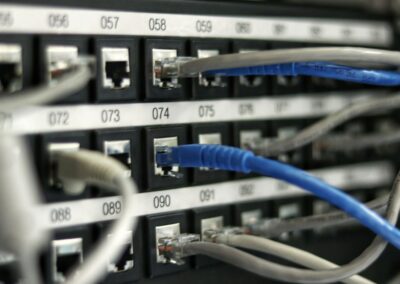Adopting Secure Software Development Life Cycle Practices for Enhanced IoT Security
Understanding the Role of Secure SDLC in IoT Security
Secure Software Development Life Cycle (SDLC) for IoT security is increasingly becoming a critical practice for organizations in Saudi Arabia and the UAE. As the integration of IoT devices into various sectors accelerates, ensuring the security of these devices through a robust development process is essential. The secure SDLC incorporates security at every stage of the software development process, from initial planning to deployment and maintenance. This approach helps in identifying and mitigating security vulnerabilities early, reducing the risk of cyber-attacks. For instance, in Riyadh’s smart city projects, employing a secure SDLC can protect interconnected systems that manage urban infrastructure, transportation, and public services. Similarly, in Dubai’s healthcare sector, secure SDLC practices ensure the safety and privacy of patient data collected through IoT devices, thereby enhancing overall trust and reliability.
Key Phases of Secure Software Development Life Cycle
The adoption of secure SDLC practices involves several critical phases that must be emphasized to ensure comprehensive IoT security. These phases include planning, design, implementation, testing, deployment, and maintenance. Each phase plays a crucial role in embedding security into the software development process.
During the planning phase, security requirements are defined alongside functional requirements. This involves threat modeling to identify potential security risks and develop strategies to mitigate them. In the design phase, secure architecture is developed to ensure that security controls are integrated into the system design. Implementation involves writing secure code following best practices and coding standards to prevent vulnerabilities such as buffer overflows and injection attacks.
The testing phase is crucial for identifying and addressing security flaws before deployment. This includes static and dynamic analysis, penetration testing, and code reviews. In the deployment phase, secure configurations are applied, and security monitoring tools are set up to detect and respond to potential threats. Finally, the maintenance phase involves regular updates and patches to address newly discovered vulnerabilities and ensure the continued security of the IoT system. By focusing on these phases, organizations in Saudi Arabia and the UAE can significantly enhance the security of their IoT deployments.
Benefits of Secure SDLC for IoT Security
Implementing a secure SDLC offers numerous benefits for IoT security, particularly in complex and sensitive environments like those in Saudi Arabia and the UAE. One of the primary benefits is the reduction of vulnerabilities, which minimizes the risk of cyber-attacks. By integrating security practices throughout the development process, potential security issues are identified and addressed early, preventing costly and damaging breaches.
Secure SDLC also enhances compliance with regulatory requirements. In regions with stringent data protection laws, such as Saudi Arabia and the UAE, adhering to secure development practices ensures that IoT solutions meet legal and regulatory standards, avoiding potential fines and legal issues. Furthermore, secure SDLC practices build customer trust and confidence. When organizations demonstrate a commitment to security, customers are more likely to trust their products and services, leading to increased adoption and market competitiveness.
In the context of smart cities, healthcare, and other critical sectors, the benefits of secure SDLC extend to ensuring the continuity and reliability of services. For example, in Dubai’s financial sector, secure SDLC can protect IoT systems that handle transactions and sensitive customer information, maintaining the integrity and availability of financial services. By adopting secure SDLC practices, organizations can create resilient IoT systems that support sustainable growth and innovation.
Implementing Secure SDLC: Best Practices and Strategies
Incorporating Security into Each Phase of SDLC
Incorporating security into each phase of the SDLC is essential for developing secure IoT solutions. During the planning phase, organizations should conduct risk assessments and threat modeling to identify potential security threats and define security requirements. This proactive approach ensures that security considerations are integrated from the outset.
In the design phase, employing secure design principles and creating a secure architecture are crucial. This involves using design patterns that enforce security controls and ensuring that security mechanisms are built into the system’s architecture. During implementation, developers should adhere to secure coding standards and best practices, such as input validation, secure authentication, and encryption.
Testing is a critical phase where various security testing techniques, such as static code analysis, dynamic analysis, and penetration testing, are employed to identify and fix security vulnerabilities. In the deployment phase, secure configurations should be applied, and continuous monitoring tools should be set up to detect and respond to security incidents in real time. Finally, in the maintenance phase, regular updates and patches should be applied to address new vulnerabilities and ensure the system remains secure. By following these best practices, organizations can enhance the security of their IoT solutions throughout the SDLC.
Investing in Training and Awareness Programs
Investing in training and awareness programs is vital for the successful implementation of secure SDLC practices. As technology evolves, it is crucial for developers, testers, and other stakeholders to stay updated with the latest security threats and best practices. In Saudi Arabia and the UAE, continuous learning programs can help build a security-aware culture within organizations.
Training initiatives should focus on developing expertise in secure coding practices, threat modeling, and security testing techniques. Workshops, seminars, and certification programs can provide valuable insights into emerging security trends and technologies. By prioritizing training and awareness, organizations can ensure that their teams are equipped with the knowledge and skills needed to develop secure IoT solutions.
Additionally, fostering a culture of security awareness among employees can reduce the risk of human errors that could compromise security. Regular security awareness campaigns and workshops can educate employees about the importance of security and how to recognize and respond to potential threats. By investing in training and awareness programs, organizations can build a skilled and security-conscious workforce that supports the successful implementation of secure SDLC practices.
Leveraging Advanced Security Technologies
Leveraging advanced security technologies is essential for enhancing the effectiveness of secure SDLC practices. Emerging technologies such as Artificial Intelligence (AI), Machine Learning (ML), and Blockchain can significantly strengthen security measures throughout the SDLC.
AI and ML algorithms can automate various security tasks, such as vulnerability detection, threat analysis, and incident response. For example, in Saudi Arabia’s energy sector, AI-driven security systems can monitor IoT devices for unusual patterns that may indicate a cyber-attack. Blockchain technology provides a decentralized and tamper-proof ledger that can secure data transactions and prevent unauthorized access. In the UAE’s financial sector, Blockchain can ensure the integrity of financial transactions conducted through IoT devices.
By integrating these advanced technologies into the SDLC, organizations can enhance their security posture and mitigate the risks associated with IoT deployments. For instance, AI-powered tools can conduct continuous security testing and monitoring, ensuring that vulnerabilities are promptly identified and addressed. Blockchain can provide a secure framework for data exchange and authentication, protecting IoT systems from various cyber threats. By leveraging advanced security technologies, organizations can build robust and secure IoT solutions that support their business goals and ensure long-term success.
Conclusion
The adoption of secure SDLC practices is crucial for enhancing IoT security in Saudi Arabia and the UAE. By incorporating security into each phase of the SDLC, investing in training and awareness programs, and leveraging advanced security technologies, organizations can effectively mitigate security risks and ensure the development of secure IoT solutions. As the technological landscape continues to evolve, organizations that prioritize secure SDLC practices will be well-positioned to protect their IoT networks, support digital transformation initiatives, and achieve business success in a rapidly changing environment.
—
#SecureSDLC, #IoTSecurity, #SoftwareDevelopmentLifeCycle, #Cybersecurity, #SaudiArabiaTech, #UAETech, #ArtificialIntelligence, #Blockchain, #Metaverse, #GenerativeAI, #BusinessSuccess, #LeadershipSkills, #ProjectManagement































